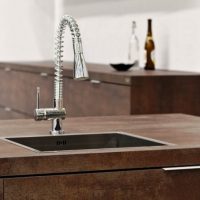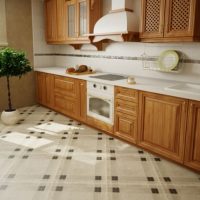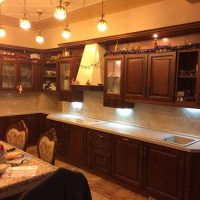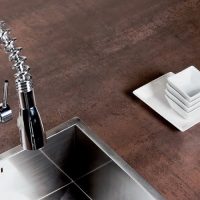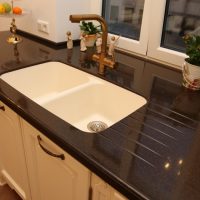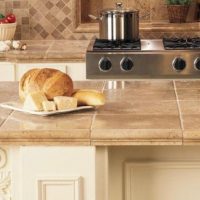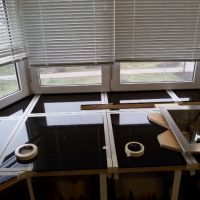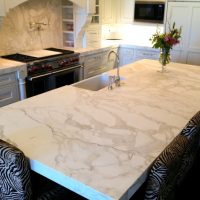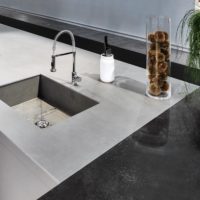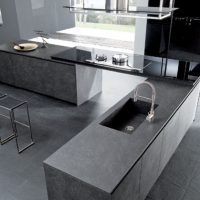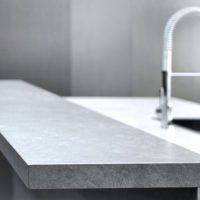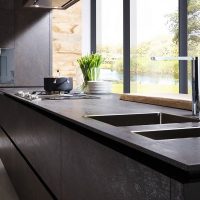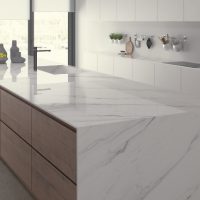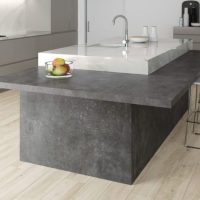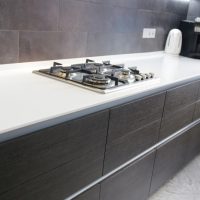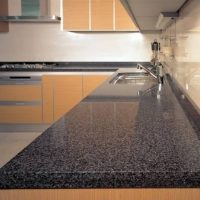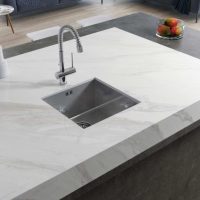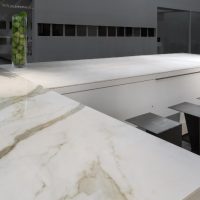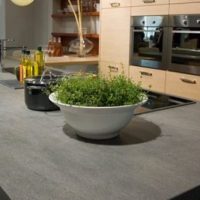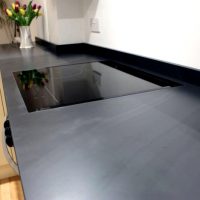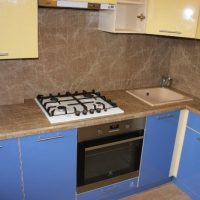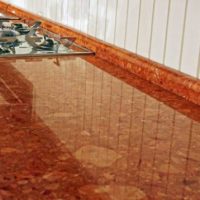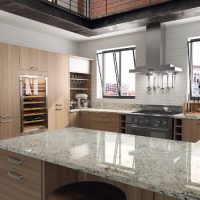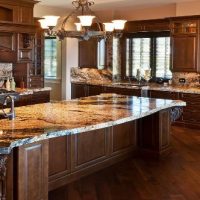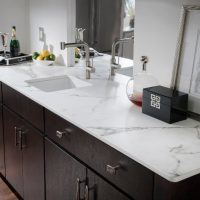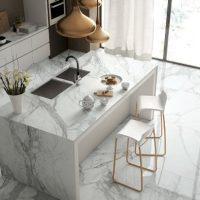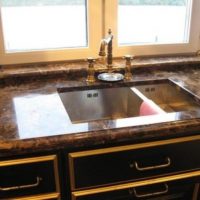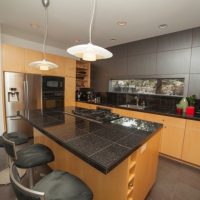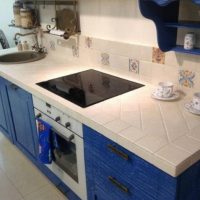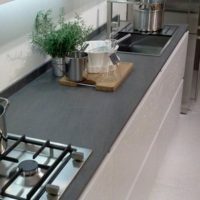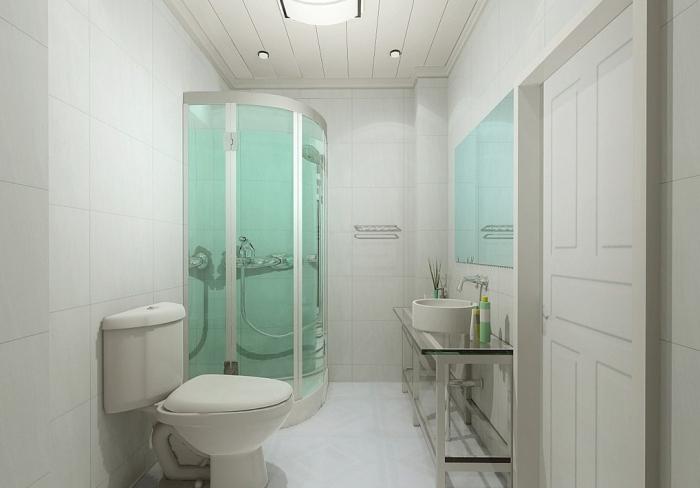Porcelain countertops in the kitchen: material features and main properties
The most important element of the kitchen is the countertop. Throughout the entire service life, it is exposed to various negative factors of the domestic environment, since all cooking work is done on it (kneading dough, cutting meat, fish, vegetables, etc.). Therefore, the countertop should have maximum strength and resistance to mechanical damage.
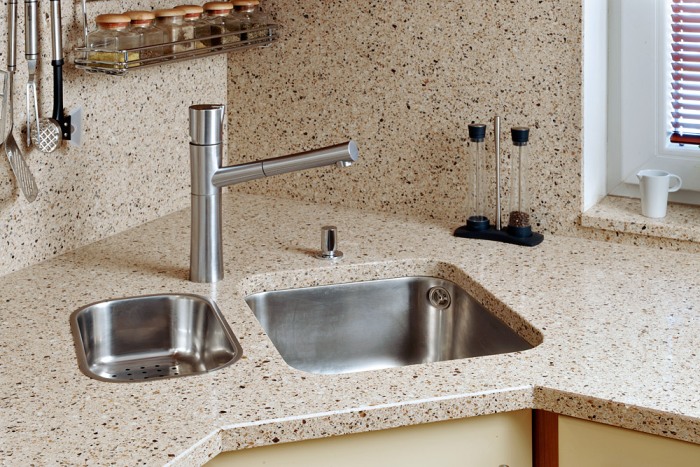
Porcelain kitchen worktops are an excellent solution for the design of a modern kitchen.
One of the best materials used to make this work surface is porcelain. In terms of its operational properties, artificial stone is no different from natural, but it has a more affordable price.
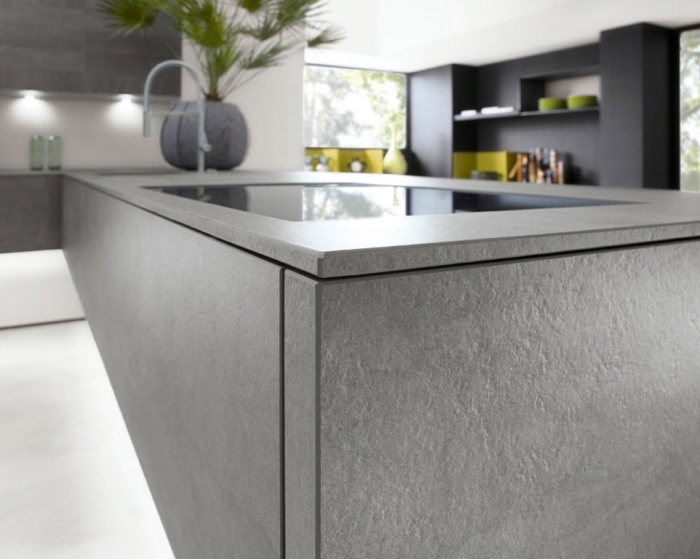
The biggest plus of porcelain stoneware is its affordable price.
Content
Features of granite countertops
Porcelain countertop is a horizontal stacked panel, the upper plane of which is lined with porcelain stoneware tiles with minimal tile joints. The space between the tiles is treated with a sealant, which avoids the flow of all kinds of liquids. The end face of the countertop is finished with the same artificial stone or supplemented with other material suitable for relief and color.
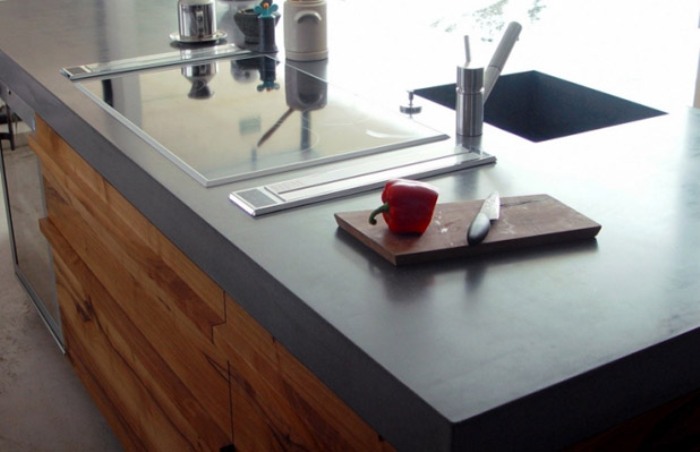
Porcelain tile is a moisture resistant material, which is an important aspect for the kitchen.
Porcelain tiles have a small weight, so they are laid on bearing surfaces from:
- a tree;
- metal;
- plastic;
- concrete.
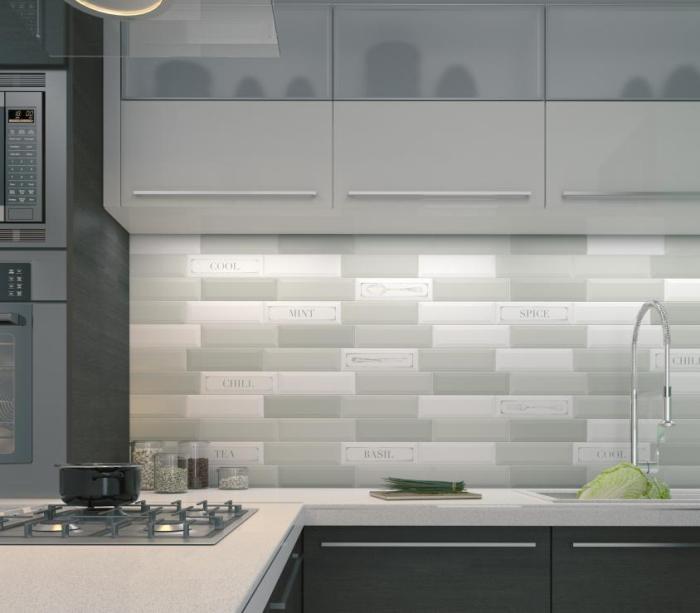
Porcelain tiles can be laid on different surfaces.
Benefits
To the main advantages granite countertops The following factors apply.
- Attractive appearance.
- Resistance to chips and cracks, as well as to chemical influences (oils, paints, detergents).
- High temperature resistance, allowing you to set the work surface next to the stove.
- The absence of harmful additives and dyes in the composition of the material.
- Durability.
- Ease of care.
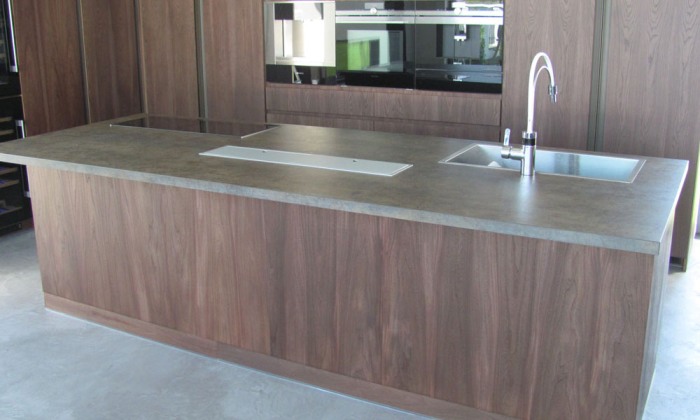
The biggest advantage of porcelain stoneware is its durability and resistance to damage.
Note! Artificial stone is presented in a large color palette, so the countertop can be matched to any kitchen interior.
Do it yourself
Installing a ceramic granite countertop is not a very time-consuming process, so you can do it yourself. The main thing is that all the tiles have smooth, polished edges and are cut strictly to size.

The installation of ceramic granite countertops can be done independently.
Foundation preparation
Porcelain tile is a tiled material, so it is placed on a strong base.
The most practical option is a bearing surface made of concrete. Before laying the tiles, it is cleaned of dust and dirt with sandpaper and primed with a solution of water and PVA glue (in a ratio of 1 to 3).
The metal base is degreased with a nitro solvent, treated with sandpaper and coated with two layers of primer (with a time interval of 3 hours). After that, a steel mesh is attached to the surface and tiled glue is applied to it evenly.
Important! Tile laying is done 24 hours after the preparatory work, so that the base is properly dried.
On a wooden and plastic surface, a moisture-resistant plywood sheet with a thickness of not more than 22 mm is placed on top. In order to avoid moving tiles resulting from changes in plywood dimensions as a result of sudden temperature changes, cement-bonded particleboards are fixed between the chipboard and porcelain stoneware.
Laying and grouting
For the installation of ceramic granite tiles, tile glue or liquid nails are used. Tiles can be laid in any way (in rows, Christmas tree, diamonds, pattern). Extreme trim elements should protrude slightly beyond the edges.

For laying porcelain tiles, ordinary tile glue is suitable.
The butt is faced in the same way as the upper plane. However, so that the tiles do not fall, they are attached to the countertop with construction tape. After the glue has completely dried, the adhesive tape is removed.
Tile joints are best filled with moisture resistant epoxy grout. If the usual cement-sand mixture is used for this purpose, after 7 days it is additionally covered with hydrophobic impregnation.
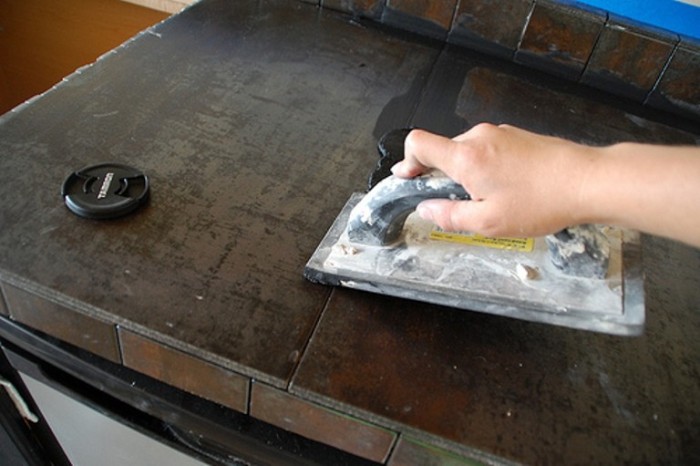
Moisture-resistant grout can be used to fill the tile joints.
Features of widescreen material
The size of the sheet of large-format porcelain stoneware is 10x30 cm. This material allows you to minimize the amount of waste during finishing work. Its cutting is carried out by a grinder with diamond discs.

For cutting porcelain tiles, you can use a grinder with a diamond disk.
Do-it-yourself porcelain tabletop
In the manufacture do-it-yourself porcelain countertops for the kitchen such rules should be followed.
- The bearing surface should be as rigid as possible. This will help to avoid movement and deformation of the tiles during operation.
- The size of the tile joints should not exceed 2 mm.
- When laying, it is necessary to check the horizontal level of the tile at the building level.
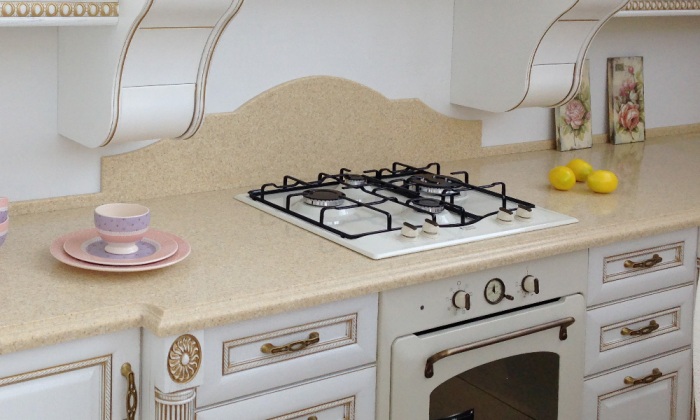
For self-installation of granite countertops, you need to follow some rules.
Care
Porcelain countertop The first time it is cleaned immediately after installing the tile. The remains of glue and grout are first moistened with water, and then removed with a weak hydrochloric acid solution. Do this with gloves so that caustic liquid does not burn your hands.
Small dirt can be removed with a dry or damp cloth. In more serious cases, acidic detergents are used.
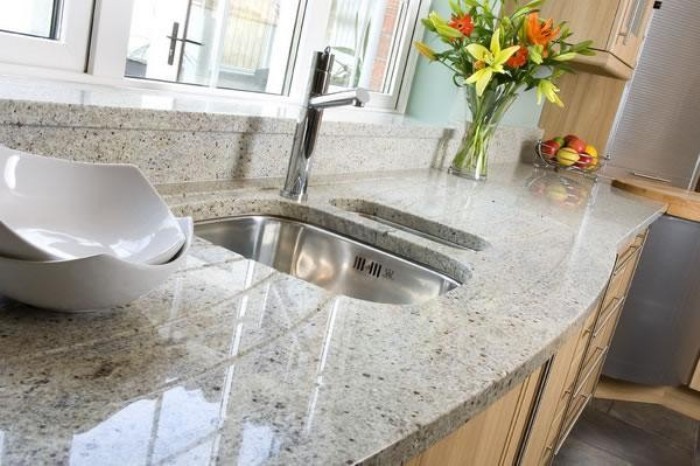
Dirt on the surface of porcelain stoneware can be cleaned with a damp cloth or sponge.
Important! It is forbidden to use abrasive pastes and powders, as they can damage the material.
Stylish ideas from designers
The countertop sets the style for the entire interior of the kitchen, so the choice of artificial stone should be approached very seriously.

The worktop should be combined with the design of the kitchen.
Designers give several recommendations regarding the cladding of the working surface with granite.
- Clinker brick tiles look good in rooms in a minimalist style.
- The tile imitating a tree will make a strict interior more cozy.
- Glossy and polished tiles match any design.

Porcelain stoneware imitating wood.
Professional advice on choosing
Porcelain tile has excellent technical characteristics, so any kind of this artificial stone is suitable for finishing the countertops. However, when buying, you must pay attention to the texture of the coating, since dirt and food debris accumulate on the relief tile, which significantly reduces its hygiene.
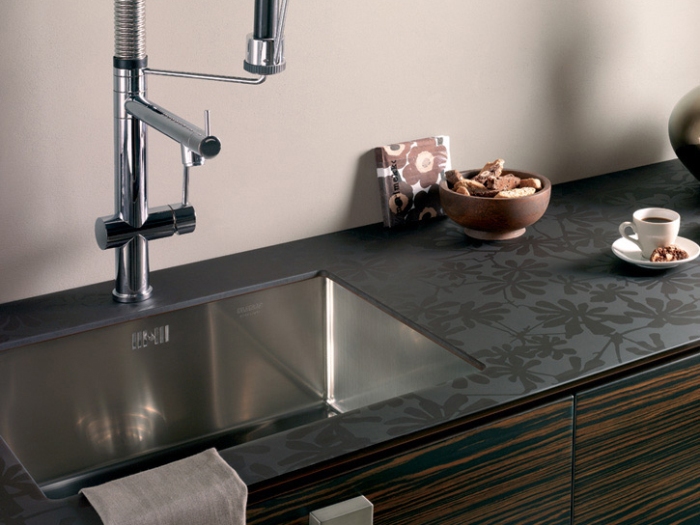
For kitchen worktops porcelain tiles with a flat surface are suitable.
Lining the countertops with porcelain tiles is very popular. Artificial material allows you to hide all the bumps on the bearing surface. In addition, it is resistant to mechanical stress, high temperatures and the growth of bacteria.
Do-it-yourself porcelain tabletop
